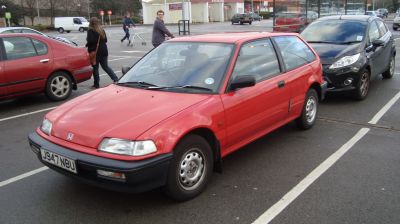 1995 Fiat Bravo (182) Dimensions, Size & Specs
1995 Fiat Bravo (182) Dimensions, Size & SpecsMeasurements of the 1995 Fiat Bravo, engineered for optimal performance and comfort
| Dimensions | |
|---|---|
| Length: | 4025-4031 mm158.5-158.7 in13.2-13.2 ft |
| Width: | 1755 mm69.1 in5.8 ft |
| Height: | 1410-1420 mm55.5-55.9 in4.6-4.7 ft |
| Trunk Capacity: | 280 liter9.9 cu ft |
| Trunk Capacity (Max): | 280-1030 liter9.9-36.4 cu ft |
| Weight Specifications | |
| Curb Weight: | 985-1190 kg2172-2624 lbs |
| Maximal permitted Weight: | 1510-1690 kg3329-3726 lbs |
| Tire Specifications | |
| Rims Sizes: |
|
| Tire Sizes: |
|
The Fiat Bravo (182) hatchback, produced from 1995 to 2002, is a compact yet spacious vehicle offering practical dimensions for urban and suburban driving. Measuring between 4025 mm and 4031 mm (158.5 - 158.7 inches) in length, it fits neatly into the compact car segment while providing ample interior space. Its width is a consistent 1755 mm (69.1 inches), contributing to its stable road presence without compromising maneuverability. The height ranges from 1410 to 1420 mm (55.5 - 55.9 inches), ensuring a low profile design that enhances aerodynamics and handling.
Curb weight varies between 985 kg and 1190 kg (2172 - 2623 lbs), offering a balance between lightweight agility and robust build quality. The maximum authorized weight spans from 1510 kg to 1690 kg (3326 - 3725 lbs), allowing for flexible passenger and cargo loads. Speaking of cargo, the Bravo delivers a standard luggage capacity of 280 liters (9.9 cubic feet), which notably expands up to 1030 liters (36.4 cubic feet) when rear seats are folded, making it versatile for daily errands or longer trips.
Tire and rim options for the Fiat Bravo (182) range from 14 to 15 inches, with compatible tire sizes including 175/65 R14, 165/65 R14, 185/60 R14, 185/65 R14, 195/55 R15, and 205/50 R15, offering a variety of choices for performance and comfort. This combination of dimensions, weight, and adaptable cargo capacity makes the 1995-2002 Fiat Bravo (182) an appealing choice in the hatchback category, balancing style, efficiency, and utility.
Discover the standout features that make the 1995 Fiat Bravo a leader in its class
Have a question? Please check our knowledgebase first.
The Fiat Bravo (182) hatchback, produced from 1995 to 2002, measures between 4025 mm and 4031 mm in length. This translates to approximately 158.5 to 158.7 inches, offering a compact footprint ideal for urban driving and easy parking. The slight variation in length depends on specific versions or equipment levels. Its length situates it well within the compact hatchback category, balancing maneuverability with sufficient interior space.
The Fiat Bravo (182) has a width of 1755 mm (around 69.1 inches) and height ranging from 1410 mm to 1420 mm (approximately 55.5 to 55.9 inches). This width contributes to a stable road presence without compromising narrow street navigation. Its moderate height ensures a low center of gravity, enhancing handling dynamics and reducing drag, while providing enough headroom for passengers to sit comfortably. These dimensions help balance drivability and comfort effectively.
The curb weight of the Fiat Bravo (182) varies between 985 kg and 1190 kg (2172 to 2623 lbs), depending on the trim and equipment levels. The relatively light weight contributes positively to fuel efficiency, as less mass needs propulsion, and benefits overall handling agility. This weight range also means the car can accelerate responsively and brake efficiently, making it suitable for both city driving and spirited rides on winding roads.
The Fiat Bravo (182) has a maximum authorized weight ranging from 1510 kg to 1690 kg (approximately 3328 to 3724 lbs). This figure includes the vehicle's own weight plus passengers, cargo, and any additional equipment. With a curb weight between 985 and 1190 kg, this means the car can safely carry a useful load of approximately 520 to 700 kg (1146 to 1543 lbs), allowing for several occupants and luggage without overloading the vehicle, preserving safety, and performance.
The standard luggage capacity in the Fiat Bravo (182) is 280 liters (about 9.9 cubic feet) with rear seats upright. This is sufficient for everyday grocery trips or small luggage. When the rear seats are folded down, the cargo volume increases significantly to between 280 liters and 1030 liters (up to approximately 36.4 cubic feet), providing much more space for large items, bulky cargo, or extended luggage needs. This versatility enhances the car’s practicality for varying transport demands.
The Fiat Bravo (182) can be equipped with rims sized 14 or 15 inches. Compatible tire sizes include 175/65 R14, 165/65 R14, 185/60 R14, 185/65 R14, 195/55 R15, 185/55 R15, and 205/50 R15. The range of tire dimensions allows owners to choose between comfort-oriented setups with taller sidewalls for absorbing bumps, or sportier, low-profile options offering better road grip and sharper handling. Rim and tire choices essentially balance ride quality with performance preferences.
Yes, the Fiat Bravo (182) fits comfortably into a standard residential garage. With a length just over 4 meters (about 13.2 feet) and a width of 1.755 meters (around 5.75 feet), it occupies considerably less space than many modern larger vehicles. Most standard garages, generally at least 2.4 meters wide and 5.5 meters deep, can accommodate this hatchback easily, leaving room for opening doors and storage in many cases. This compactness enhances convenience for urban and suburban owners.
Compared to the first-generation Fiat Bravo/Brava, the Bravo (182) introduced in 1995 is similar in overall size but with modest refinements. The length remained close to 4 meters, while the width of 1755 mm represents slight improvements in interior space. Height variations in the second generation contributed to a slightly lower profile, aiding in aerodynamics and styling. Overall, the Bravo (182) offered improved packaging efficiency and a more modern design while maintaining the compact hatchback dimensions that appealed to buyers.
The Fiat Bravo (182) competes closely with other mid-1990s compact hatchbacks such as the Volkswagen Golf Mk3, Ford Escort, and Opel Astra of the time. Its length around 4 meters and width near 1.75 meters place it well within the segment average. While some rivals might offer larger luggage space, the Bravo’s versatility with up to 1030 liters with folded seats was competitive. Its relatively low curb weight and compact dimensions contribute to agile driving dynamics and practical urban usability, matching or exceeding standards set by competitors.
The Fiat Bravo (182) is a compact hatchback known for its sharp styling, agile handling, and efficient use of interior space. Produced between 1995 and 2002, it was appreciated for its lightweight construction, which improved fuel economy and responsiveness. Multiple engine options and trim levels were available to cater to different buyer needs. With practical cargo capacity and a relatively low ride height, it struck a balance between comfort, everyday utility, and engaging driving experience. The Bravo is historically recognized for modernizing Fiat’s compact hatchback offering during the late 1990s.
Discover similar sized cars.

| Production: | 1999-2001 |
|---|---|
| Model Year: | 1999 |
| Length: | 4025 mm158.5 in |
| Width: | 1755 mm69.1 in |
| Height: | 1420 mm55.9 in |

| Production: | 2018-present |
|---|---|
| Model Year: | 2019 |
| Length: | 4029 mm158.6 in |
| Width: | 1940 mm76.4 in |
| Height: | 1409-1433 mm55.5-56.4 in |

| Production: | 1994-2006 |
|---|---|
| Model Year: | 1994 |
| Length: | 3995 mm157.3 in |
| Width: | 1698-1710 mm66.9-67.3 in |
| Height: | 1365 mm53.7 in |

| Production: | 1987-1995 |
|---|---|
| Model Year: | 1987 |
| Length: | 3991 mm157.1 in |
| Width: | 1686 mm66.4 in |
| Height: | 1330 mm52.4 in |

| Model Year: | 2022 |
|---|---|
| Length: | 4108-4137 mm161.7-162.9 in |
| Width: | 1954 mm76.9 in |
| Height: | 1458-1482 mm57.4-58.3 in |
